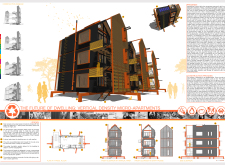5 key facts about this project
The design focuses on creating sustainable living spaces in an urban environment, specifically through the development of micro-apartments. These units are intended to support a high density of residents while also encouraging an eco-friendly lifestyle. The overall concept integrates various modern technologies to ensure self-sufficiency in energy, water, and food by creating living environments that are both functional and efficient.
Energy Solutions
Solar panels and solar heaters are used to provide hot water and electricity within the micro-apartments. Each unit features a Tesla power-wall battery, enabling residents to store energy for use at night. An atmospheric water generator (AWG) is included to convert humidity from the air into drinking water, greatly enhancing the units' self-sufficiency. This approach reduces reliance on municipal water systems and encourages a more sustainable way of living.
Water Management
Efficient water management is a key aspect of the design. The system incorporates grey water recycling and a rain catchment system, with collected water stored in tanks located underground. This strategic design helps to free up space within the living units while addressing essential water needs. The focus on reducing environmental impact ensures that the micro-apartments operate independently, catering to both practical and ecological concerns.
Interior Design and Space Utilization
Inside the micro-apartments, an open-plan layout is used to maximize the functional use of space. Built-in elements along the walls serve multiple purposes, including a murphy bed, seating, storage, and shelving. These features work together to create a compact yet comfortable living environment. The design also makes use of large windows, providing natural light and ventilation. This contributes to a pleasant atmosphere and ensures that the apartments are inviting spaces for residents.
Materiality and Structural Framework
Prefabrication techniques are employed to simplify the construction process, with a spider foundation system that can adapt to various types of ground. The exterior of the micro-apartments is cladded in metal, offering durability, while aerogel insulation enhances thermal performance. Inside, particle board is used for walls and surfaces, and bamboo flooring contributes to a warm and natural aesthetic. Hydroponic systems are also integrated into the design, allowing for vertical farming that supports food production, further emphasizing the project’s commitment to sustainability.
The design balances modern living with environmental awareness, creating small but meaningful spaces. It offers a practical solution to urban housing challenges while promoting a lifestyle that is conscious of resources and the surrounding environment.



















































